This article was originally written for a US firearms magazineHow many of us would walk down a city street openly counting a roll of hundred-dollar bills? Yet we drive vehicles worth thousands of dollars down those same streets, and feel safe. Criminals are not known for their ability to resist temptation, and in this age of plastic currency the car may well be their most attractive target. Carjacking is definitely the trend crime of the Nineties, and it's a massive international business. One British victim saw his Range Rover on TV news being driven by Afghan rebels!
In our training of VIP Close Protection Teams we have had to include response drills to Carjack threat. Usually, our work is based on the VIP himself being the target, but recently the up-market VIP vehicle may be the target, and our training has had to be modified accordingly. I train personnel in South Africa frequently, and the Carjack problem there is probably the worst anywhere. In the Greater Jo'burg area armed carjackings are running at an average of 23 per day. A couple of years back we started offering a specialised course to analyse Carjack methodology, and teach a total "package" of response options. This article is based on that program. No article can replace "hands-on" training, and I would encourage readers to attend a professional course. H&K International Training Division run a superb course, restricted to Law Enforcement Personnel. Several trainers do offer courses open to civilian shooters.
There has been a switch from the theft of parked cars to Carjacking. Just as the sophistication of bank vaults made "safe breaking" obsolete, encouraging criminals to turn to armed robbery of banks and armoured trucks; so the increasing sophistication of vehicle security/alarm systems has caused a growth in the violent robbery of motor vehicles.
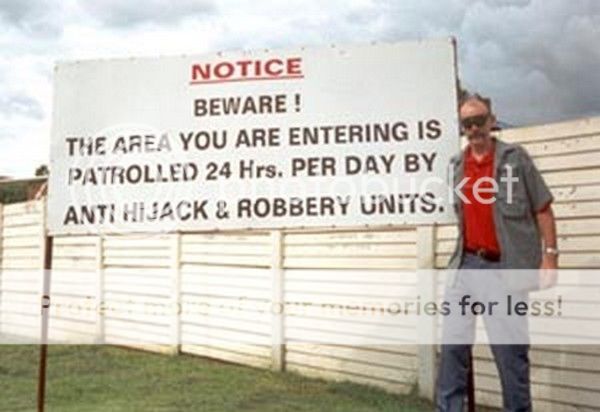 CARJACK METHODOLOGY
CARJACK METHODOLOGYHow do you hijack a car? You force the driver to comply, either by threat of shooting, or, by smashing windows, opening doors and extracting the driver by physical force, often reinforced by knife threat.
Wherever there is a chokepoint, where a vehicle may predictably stop, or, slow right down,( such as intersection, off ramp, gas station, market, parking areas etc), then a lurking carjacker can act. Victims can be literally anyone, and have included Diplomats, other criminals, and off-duty police officers! Obviously sites will be selected that favour the robber (dim light, few witnesses, easy escape roads). At such "chokepoints" there have been frequent cases of players throwing rocks, spark plugs, or, using ball bearings from a slingshot to break the windscreen/windows. They then either snatch belongings, the car keys, or, drag you bodily through the smashed Plexiglas.

[Carjack caught on CCTV in Jo'burg]
Alternatively, an "accident" is manufactured in order to stop the vehicle. "Tail-light Bandits" will bump the car, and go into action when the driver exits to exchange details. On rural roads, accidents may be staged to encourage a car to stop and help. At your residence the gate may be blocked, when you get out, they get in!
A less frequent method is the "Rolling Ambush". Another vehicle cuts across and forces you off the road. Alternatively two, or, more vehicles box you in and force you to stop. Weapons may be displayed/fired. In South Africa attackers have jumped from taxis onto the hood of target cars!
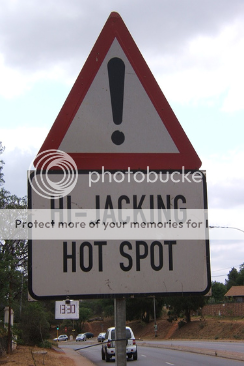
Although the majority of attacks are opportunistic, there are a significant number of vehicles stolen to order. Your car is spotted, and a potential buyer arranged. You may be followed for some time before the attack, which may occur as you approach your residence, or, workplace.
All carjackings involve force, or, the threat of violence. Victims have been assaulted (pistol-whipping/beaten to ground etc) to extract them quicker, and many have been subsequently sexually assaulted. Some victims have been shot/ killed, even after complying. Cars have been driven off with babies still in rear seats. In some cases they have been "dumped" further down the road.
VEHICLE HIJACKING: THE RESPONSEYou know about the dangers of urban life, and the predators that infest our cities, but as you speed down the streets, cocooned in an "encapsulated environment" you are you remote and protected...until you stop. Like a flash it happens, you are looking at the wrong end of a gun, and you are another victim, one who thought it would never happen to him. There are four components to our personal protective "package": Mindset, Tactics, Skills and Equipment. We can prepare to fight our way out of the problem, and if all else fails we may need the hard option, but it is better to avoid the confrontation. The key to this is Mental Posture.
 [The South African Police have a special Anti-Highjack Unit]MINDSET
[The South African Police have a special Anti-Highjack Unit]MINDSETThe first element of the Mindset phase is preparation, finding out about the methodology of the attack, case histories, news items. From this go into a planning stage, where you do a series of "what ifs". Mental visualisation is essential; "see" yourself performing in the situation. Next comes rehearsal where you go through simulated attacks in a scenario situation. Ideally, you would do this under professional supervision, but tactically minded friends/colleagues could set these up for you. The final phase is situational awareness, used when actually operating. We will discuss this in detail.
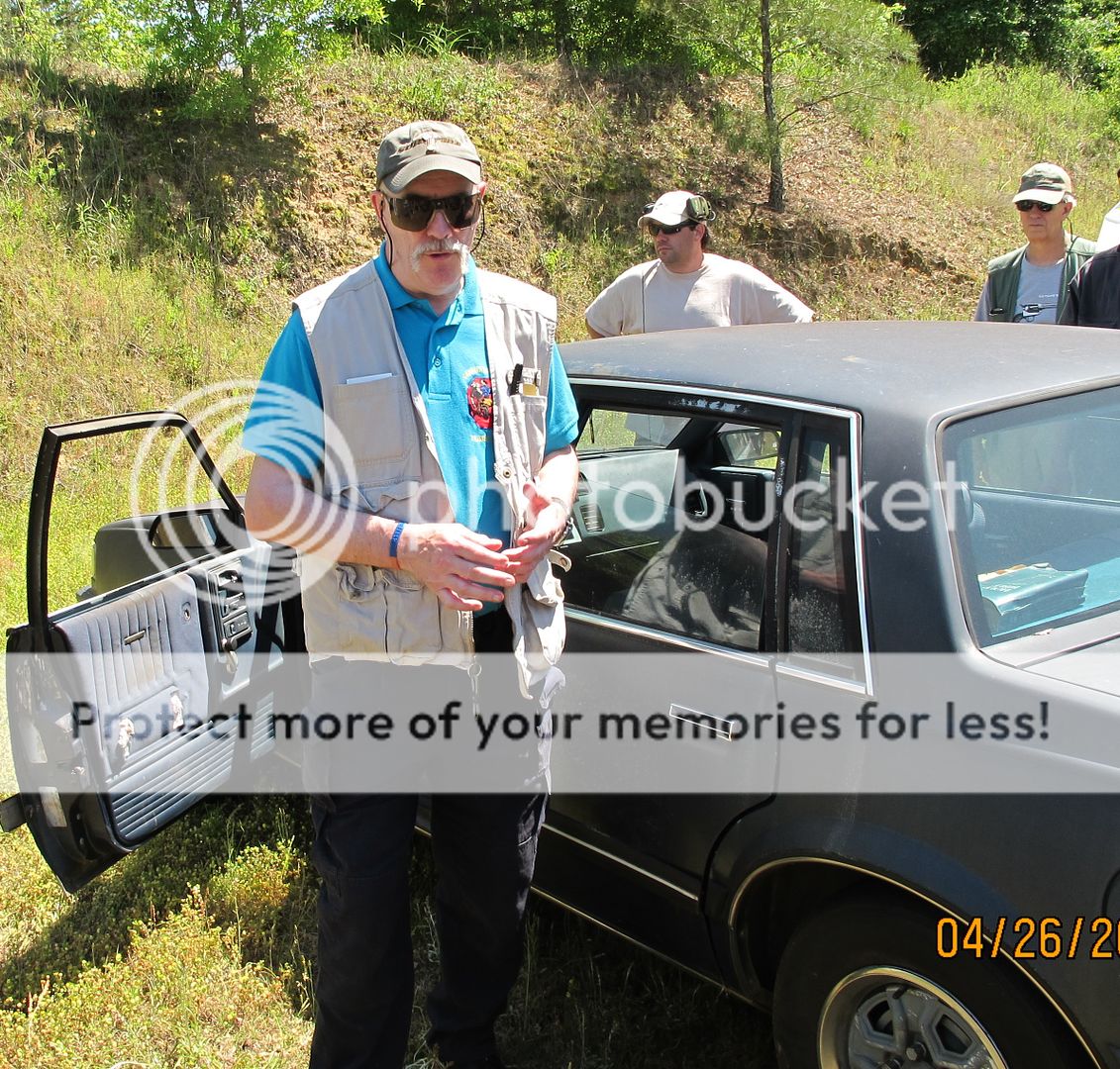 [Den discussing vehicle tactics]
[Den discussing vehicle tactics]The well-known concept of "defensive driving" can be extended to cover potential attacks, as well as traffic hazards. You should have your "mental radar" pulsing out, in Jeff Coopers' renowned Condition Yellow. From the above preparation phase you are already aware of the patterns of attack, so you are alert for any attack indicators. Whenever you come to any "chokepoint" you are especially alert.
A good training method is to practise commentary driving, giving a continuous verbal commentary as you drive. This is how we train the bodyguards to increase awareness. Every feature, vehicle, hazard etc is noted and described. Eventually it becomes automatic.
When actually in a critical situation the OODA-Loop concept, taught by Marcus Wynne, enables you to process threat information and respond with the appropriate action. We have found the system highly relevant.

Being "switched on" gives you time, and time gives you options- to make decisions, to avoid, to escape. If you are driving in a rural area and you encounter a body in the road you should stop, reverse-out, then seek help. If the "body" jumps up and runs off, this is known in the trade as a clue! Leaving a possible casualty is not callous. Current European first aid training insists that with an unconscious casualty your first priority is to call for professional assistance. Faced with just such a "body" in the road, a South African women drove her 4x4 off road, going around the problem. She ran over two attackers hiding in the bushes and killed them!
TACTICSTactics allow you the maximum advantage in a situation. In a Carjack context tactics are not specialised, but must be adopted as part of your normal driving habits.
The first area to consider is parking the car, as this is a prime location for an attack. Try to park near the pay booth, or, the exit. Avoid areas which afford cover to a lurking attacker, such as bushes and low walls. Consider the lighting, it may be dark when you return to the vehicle. Reverse-in, so that you can drive straight out. Visually check the interior before opening the door, then use a tip from the bodyguards and back into the car, facing outwards so you can maintain visual scan.
Know exactly where the door handle is, especially in a strange car. You may need to exit quickly. Always drive with all doors locked. The bad guys look for the locking catch when assessing victims. A woman in South Africa left the doors unlocked and at a stop-light a well-dressed guy, with a briefcase and a pistol got in and told her to drive. Along the way he produced a cellular phone and made a call to a potential buyer describing the car, colour and mileage. When the buyer rejected the offer the guy told the woman to pull over, wished her "Good Day" and walked off.
When approaching a red light slowly "creep" up, to avoid stopping. If you must stop, allow yourself escape room between your car and the one in front.
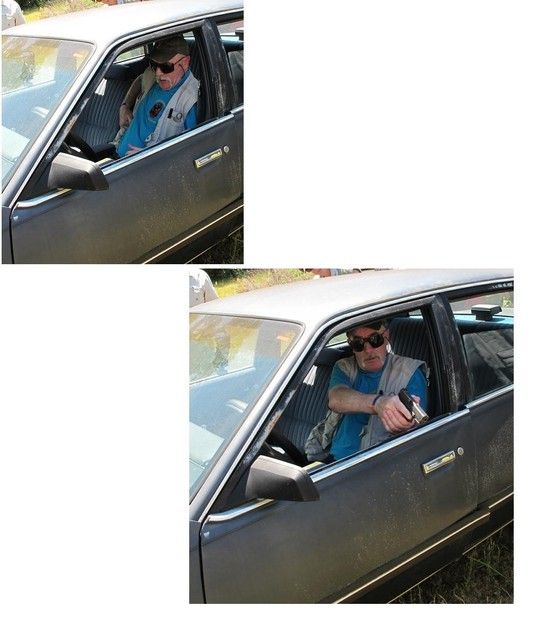 TRAINING
TRAININGThis phase involves the various skills needed to avoid, or, react to an attack.
We have already mentioned Defensive Driving. This includes route planning, so that any stops, such as refuelling are done in low-crime areas. Added to this is Evasive Driving, which is a specialised skill, and we recommend attending professional training. The Scotti School is World renowned for all aspects of driver training. This installs the ability to manoeuvre out of danger. A typical program would include forward/ reverse slaloms, and J-turns. Finally, Offensive Driving allows breaking contact by ramming, or, using the car as a weapon.
A firearms training program should include weapon presentation from covert-carriage, seated presentations, multiple-target engagement and firing from vehicle cover positions. The shooter should then be introduced to firing from within the vehicle. Here it is often found necessary to modify the carriage method, or, position. Drills should include engaging through the open window, and also exiting then engaging.
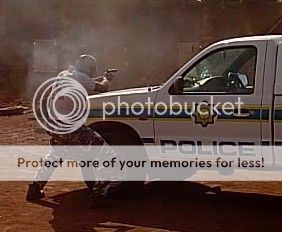
Once the shooter is adept at accessing the weapon within the vehicle, he should experience firing through the windscreen and side windows. Under threat, as you forcefully extend the weapon there is a tendency to punch the window. This can cause you to lose your grip, to miss, or induce a stoppage. Allow a gap between muzzle and window. Multiple shots should be fired, especially through the windshield. Eye and ear protection is essential.
EQUIPMENT CONSIDERATIONSYour usual choice of defensive pistol will probably be fine for a Carjack situation. I would avoid a "Magnum", because of the blast within the vehicle. Ammunition should penetrate auto glass and still incapacitate. Since this is a requirement of the FBI Ammunition testing protocols, and most current ammo is designed to comply with those standards, this is no problem.
Holsters present some interesting problems. As you train to access the weapon within the vehicle, you may find that your normal covert-carriage system does not suit vehicle use. If your usual carriage mode is at the hip. or, small-of-the-back you will have severe access problems. Seat belts add further difficulties, binding the jacket to the body and further hindering access. This is further complicated by which side you are seated; driver-side, or, passenger side. The seatbelt angle presents different problems in each case. You will need to find a system that works for all situations, work, leisure, on foot, driving right/left side. You may find that a shoulder-rig, a crossdraw, or, appendix-position holster will work better with seatbelts. If these work while out of the car too, go for it.
It may be thought that repositioning the weapon would be an option, and in fact, "driver"-type holsters are designed for this very purpose. Well, this is not advised. Changing weapon position every time you enter, or, exit the car is bound to frighten some passing citizen, who will call the police and you will be trying to understand your Miranda rights while looking down a muzzle. Not a good plan! Additionally, Carjack response involves the option of exiting the vehicle, and these holsters are not very secure when standing. I use Kramer horsehide IWB holsters, and find I can access them inside a vehicle, but what works for me may not work for you. Try various options, and, above all practice.
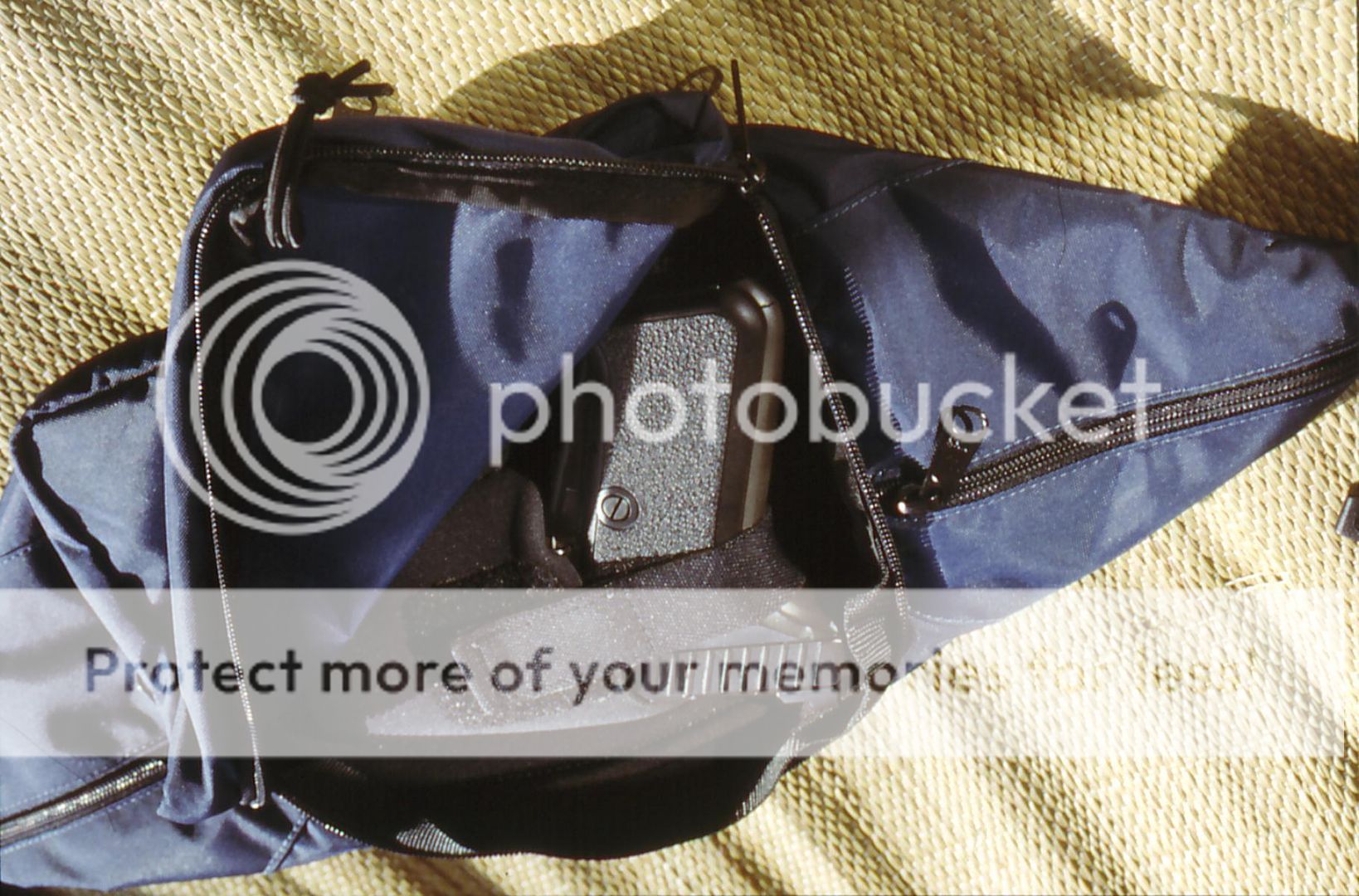
An option to consider is the Fanny-pack holster which is not affected by the seatback, or, seatbelts, and has equal utility inside or, outside the vehicle. I realise these belt-pack carriers are in some way the signature of a shooter, but with imagination you can lower the profile considerably. Above all, avoid black Cordura!
CAR GUNSTo ensure fast access some shooters place the pistol under the thigh. There are lots of negatives with this. Firstly, you have the same problem as with the driver-holster, having to surreptitiously reposition the weapon every time you get in, or, out of the vehicle. As we have seen that's an arrest situation waiting to happen.
Secondly, one of your tactical options involves offensive driving, and violent manoeuvring may dislodge the weapon. Cases from Belfast to Zimbabwe prove this point. As we saw in the infamous "Miami Massacre" two FBI agents lost their weapons because they had placed them under their thighs. During the violent vehicle activity of the felony car stop, the weapons slid free and were lost. One agent was completely unarmed, the other went to his backup Chiefs' Special.
Special Ops units involved on covert duties may have a car gun, under the thigh, in the door pocket, between the seats, or, behind the sun-visor (accessible from the "hands up" position). However, they will always have their main weapon actually on the body. The above lessons have been well taken. Such units have a range of classified devices fitted to their vehicles to distract, or, repel attackers. Commercial companies are currently developing alternative options which include OC dispenser-nozzles and a system which delivers electric shock via the door handles. I have seen tests of this system, done using unwitting "volunteers", and the results were both effective and hilarious!
Other equipment to consider includes ballistic eye protection, and extra interior mirrors to eliminate any blind spots around the vehicle.
Finally Satellite Tracking is available in some areas. It won't prevent a hi-jack, but it will help recover the vehicle. Currently this system has over 90% success rate.
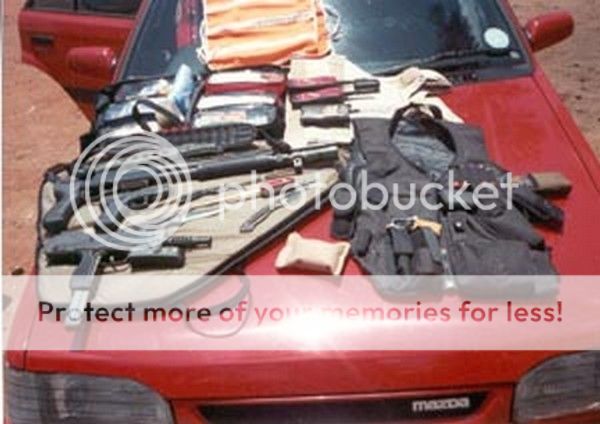 THE ARMED OPTION
THE ARMED OPTIONIf faced with a vehicle hijack attempt the driver has the following options:
Escape (drive off)
Fight
Submit.
. Escape is the best option, but it may not be always possible.
Fighting can be done by ramming the attacker, by tackling him with empty hands (at close range only), or, by armed response.
Submission doesn't mean surrendering. It means you have made the considered decision to give up your car rather than engage in a gunfight, which, even if you win, will have severe legal and financial consequences. Remember, there is a chance you will get your car back. However, by the same token submission means you have drawn a line, set a mental trigger, and will still fight if necessary.
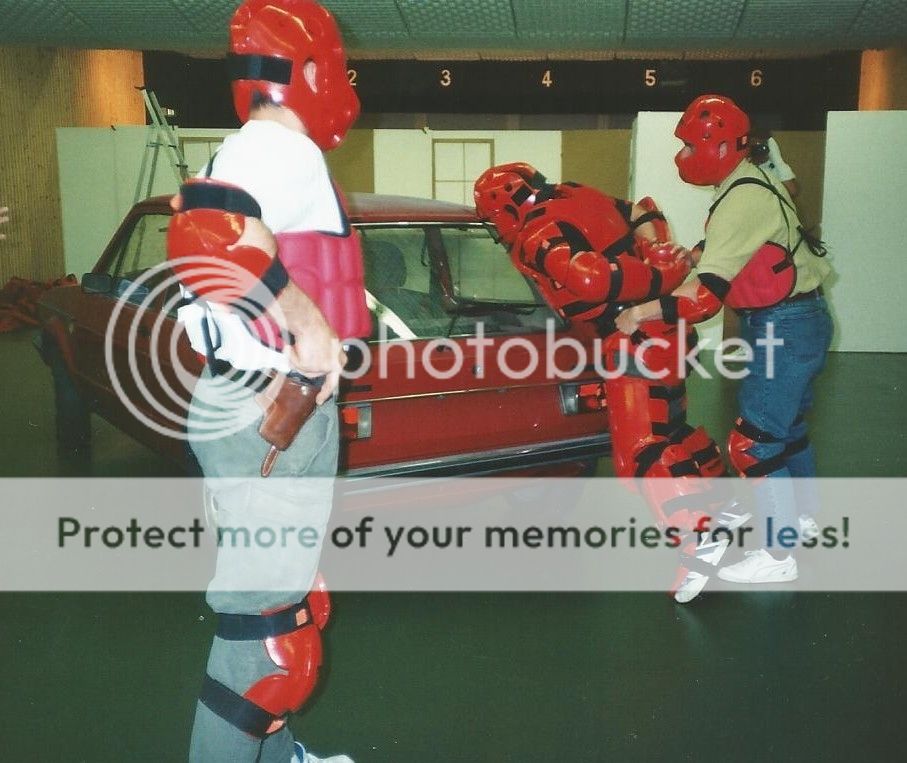 [ Any training course should include Scenario work. These trainees on a course in Europe prepare for a vehicle scenario, using REDMAN:tm: suits and SIMUMITIONS:tm: modified weapons.]
[ Any training course should include Scenario work. These trainees on a course in Europe prepare for a vehicle scenario, using REDMAN:tm: suits and SIMUMITIONS:tm: modified weapons.] Unfortunately, neither I, nor any other instructor, can give you clear cut guidelines on when to submit, when to fight, in an article. It's situational. Only you can assess all the factors, as they are happening, and make the appropriate decision. This is why hands-on training is so important. Scenario work, using Redman :tm: suits and Simumitions :tm: gives you the experience in a controlled learning environment.
If you decide to fight there are two main options:
A} Immediate counter-attack, either ramming, or, firing from within vehicle.
B} Exit the vehicle and counter-attack.
Factors to consider include whether you see the threat far enough in advance, whether you are taking fire (in which case you must counter-attack), or whether you can create a "window of opportunity" to access your weapon.
Avoidance and escape are much better options, but we must be prepared to fight. But, it's a decision that only you can make....because you are going to have to live with the consequences. It's big boys rules!
I finish with a quote from Colonel Mike Henning, a highly experienced police SWAT instructor:
"We avoid the fight if we can, but if we must fight, we must win. Avoidance, or, victory, there is no other option."
COPYRIGHT :copyright: DENNIS MARTIN
LINKS:
Counter Carjacking and Critical Path Design by Marcus WynneAvoiding attacks while Driving by Marcus Wynne 